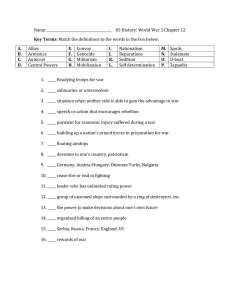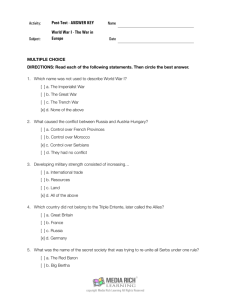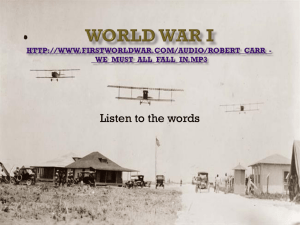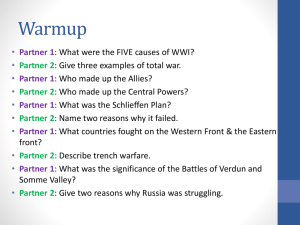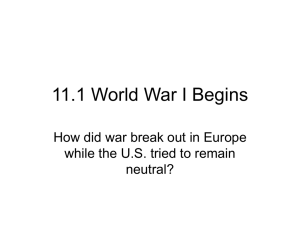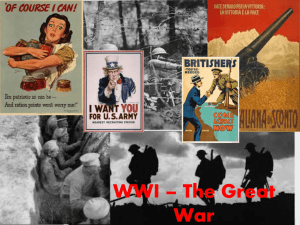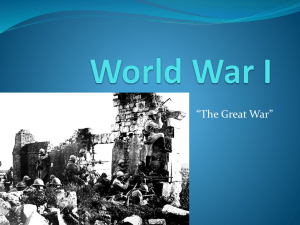World War i
advertisement
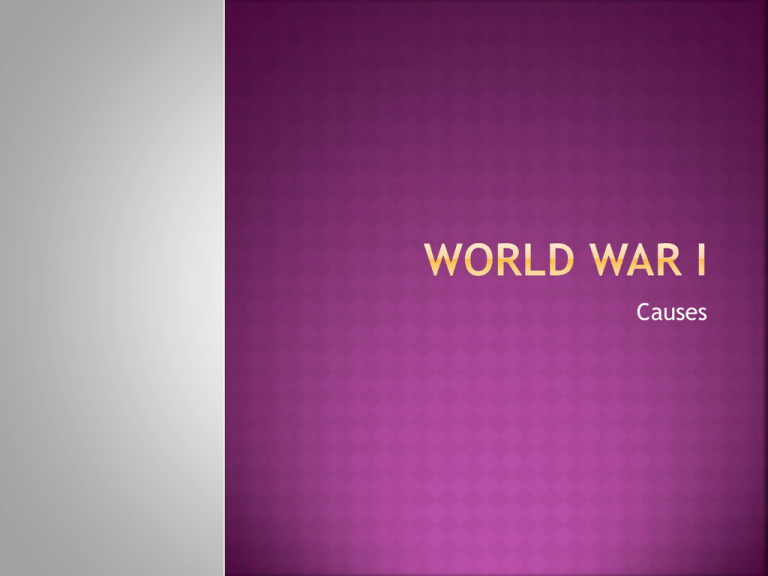
Causes N I M Sa Nationalism Imperialism Militarism Strategic Alliances Assassination of Archduke Francis Ferdinand Tendency for countries such as the great powers to act in their own national interestswhen these interests went against those of another country, warfare could easily result Alsace-Lorraine dispute The longing of an ethnic minority for independence Competition for colonies in Africa, Asia, and the Pacific led to frequent disputes between the Great Powers in the 1895-1914 period The great powers of Europe- Austria, Hungary, France, Germany, Great Britain, and Russia all spent large sums of money in preparation of war Made war all that much more likely! Complicated system of alliances between the great powers meant to bolster security- the alliances bound the great powers to come to each other’s aid in the event of attack Germany and Austria-Hungary Russia and France Great Britain and France- looser alliance called the Entente Cordiale or simply Entente Triple Entente Great Britain France Russia Triple Alliance Germany Austria-Hungary Italy Begins http://www.pbs.org/greatwar/maps/index.h tml While in Sarajevo, Francis Ferdinand, heir to the Austrian throne, and his wife, Sophia, were assassinated Black Hand- Serbian terrorist organization dedicated to the creation of a pan-Slavic kingdom Austria-Hungary declares war on Serbia Serbia’s protector, Russia, mobilizes as well as France, Russia’s ally Germany demands that Russia stop mobilizing. When Russia refuses, Germany declares war on Russia Germany develops first strike strategy (Schlieffen Plan) and passes through Belgium a neutral territory causing Great Britain to enter the war All world powers now a part of the war! Central Powers Allies Germany Russia Austria-Hungary France Serbia Great Britain The War Western Front Schlieffen Plan fails- Germany stopped 20 miles outside of Paris at the First Battle of Marne Stalemate- two lines of trenches extended from the English Channel to the frontiers of Switzerland trench warfare kept both sides virtually immobilized for four years Eastern Front Russians decisively beaten at the battles of Tannenburg and Massurian Lakes- Russians no longer threat to German territory After initial Austrian defeats, German-Austrian army push Russians back 300 miles into their own territory Russian casualties stood at 2.5 million killed, captured, or wounded. The Russians had almost been knocked out of the war! Germans, Austrians, and Bulgarians attack Serbia and eliminate Serbia from the war After successes on the Eastern Front, Germany again focuses offensive in the west. Trench warfare leads to massive deaths and unimaginable horrors 1917- Not a good year for the Allies! Italians badly defeated Russia withdraws from the war- Bolshevik Revolution Central Powers Germany Austria-Hungary Ottoman Empire (1914) Bulgaria (1915) Allies Russia Serbia France Great Britain Italy U.S. (1917) U.S. tries to remain neutral Sinking of the Lusitania May 7, 1915- Germany sinks British Lusitania as part of unrestricted submarine warfare- 100 American deaths result Germans stop unrestricted submarine warfare to appease Americans Zimmerman telegraph Germans want to start unrestricted submarine warfare again to starve out the British German foreign minister Alfred von Zimmerman secretly encourages Mexican government to launch attack to recover lost Mexican territories British intercept and decode telegraph and show it to U.S. diplomats in London April 6, 1917 Extension of Government power to meet war time needs Mass conscription/military draft Free-market capitalistic systems temporarily shelved as governments experimented w/ Expansion of police powers to subdue dissatisfied populations price, wage, and rent controls, the rationing of food supplies and materials, the regulation of imports and exports, and the nationalization of transportation systems and industries All citizens constituted a national army dedicated to victory Dissenters suppressed and censorship of newspapers Made active use of propaganda to arouse enthusiasm for the war End to unemployment Withdrawal of millions of men from the labor market to fight + heightened demand for wartime products led to jobs for everyone New roles for women Called upon to take over jobs and responsibilities that had not been available to them before, including jobs that had been considered beyond their abilities Women begin to demand equal pay for equal work Temporary? Leads to new independence- young women took jobs; had apartments; smoked in public; wore shorter dresses; cosmetics; new hair styles Last German gamble to break stalemate in the west Germans launch grand offensive in the west Allies launch counterattack using fresh American troops and defeat Germans at the Second Battle of Marne on July 18 Allied forces advance steadily on Germany Exhausted and angry German people establish a new republic and force William II to abdicate End of the War- November 11, 1918 10 million soldiers dead 5 million Allied 3.5 million Central Powers Civilian deaths were nearly as high! Almost 2 million in France alone (1/10 of the entire male population!) Peace Settlement Attended by delegates from 27 Allied nations Wilson- Fourteen Points- outlines justifications for the enormous military struggle Later spelled out additional steps for a truly just and lasting peace Too idealistic in the face of more pragmatic leaders? Lloyd George- British Prime Minister who had won a decisive electoral victory on the platform of making Germany pay for the dreadful war Georges Clemenceau- French premier who had led his country to victory and wanted Germans to pay Woodrow Wilson- U.S. President that wanted international cooperation- wanted to create a League of Nations to prevent future wars Creation of a League of Nations- tabled for duration of conference France wanted a separate Rhineland as a buffer state, but accepted a defensive alliance w/Great Britain and U.S. who pledged to come to the aid of France if attacked by Germany Five separate treaties with the defeated nations Considered a harsh peace by Germans Especially unhappy with the guilt clause Declared Germany and Austria responsible for starting the war and ordered Germany to pay reparations for all the damage to which the Allied governments and their people had been subjected to as a result of the war “imposed upon them by the aggression of Germany and her allies” Had to lower its army to 100,000 men; Reduce its navy; Eliminate its air force Return Alsace and Lorraine to France and section of Prussia to the new Polish state German land west and as far as 30 miles east of the Rhine was established as a demilitarized zone and stripped of all armaments or fortifications to serve as a barrier to any future German military moves westward against France Extensively redrew the map of Eastern Europe! German and Russian empires lost considerable territory Austro-Hungarian Empire disappeared New nation-states Finland, Latvia, Estonia, Lithuania, Poland, Czechoslovakia, Austria, Hungary Romania gained lands from Russia, Hungary, and Bulgaria Serbia formed the nucleus of a new South Slav state called Yugoslavia which combined Serbs, Croats, and Slovenes Paris Peace Conference attempted to draw territorial lines according to the principle of self-determination, but the mixtures of peoples in eastern Europe made it impossible to draw boundaries along neat ethnic lines Compromises were made . . . Sometimes to satisfy the national interest of the victors Result- virtually every eastern European state was left with a minorities problem that could lead to future conflicts! Germany and Russia did not accept these changes

